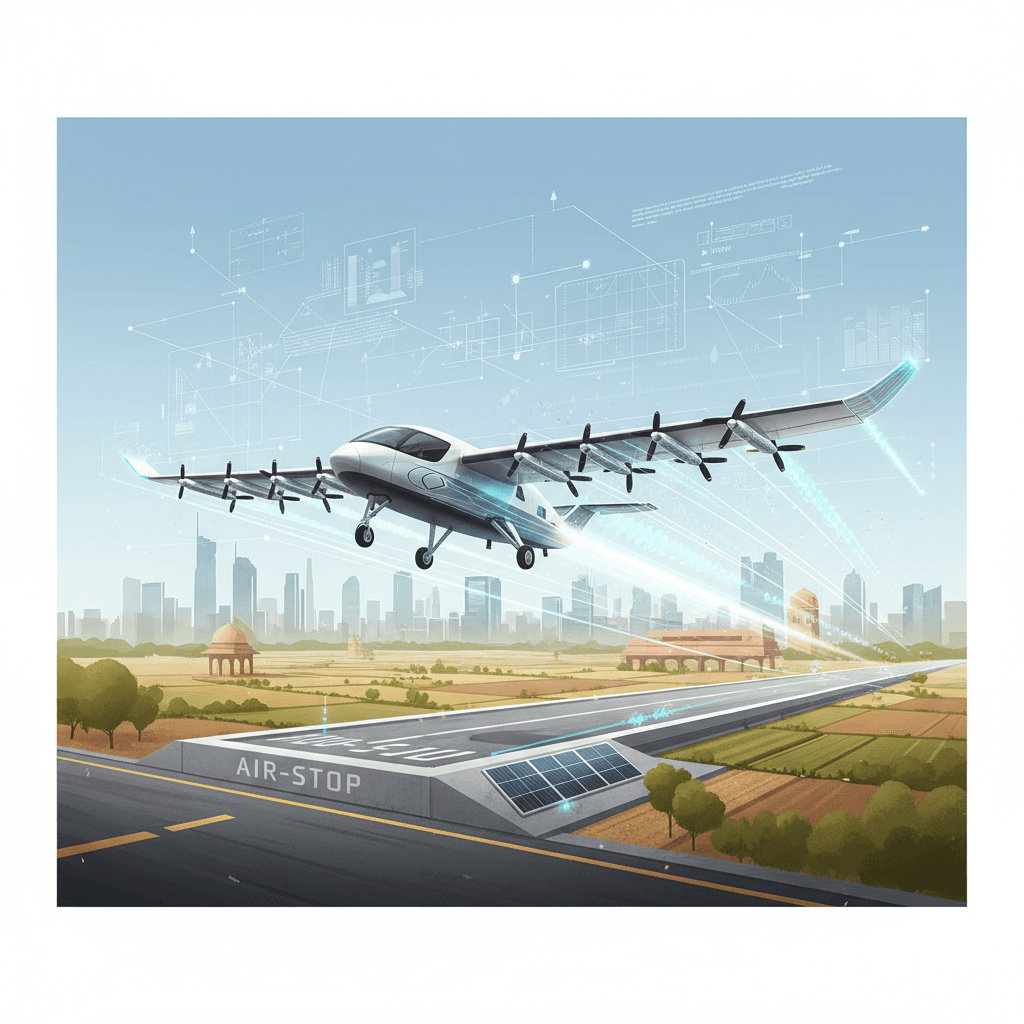AI Drives India's Aviation Revolution: Zomato Founder's uSTOL Aircraft Nears Flight
Deepinder Goyal's LAT Aerospace readies ultra-short takeoff aircraft, envisioning "buses in the sky" to revolutionize India's regional travel.
November 13, 2025

In a significant step forward for India's aviation ambitions, LAT Aerospace is making final preparations for the maiden flight of its first ultra-short take-off and landing (uSTOL) technology demonstrator.[1] The company, founded in January 2025 by Zomato co-founder Deepinder Goyal and former COO Surobhi Das, has successfully completed ground roll tests of the fully electric, fixed-wing unmanned aerial vehicle (UAV).[2][3] This pivotal milestone signals the near-term validation of a technology that could fundamentally reshape regional connectivity across the subcontinent. The demonstrator aircraft, developed in a remarkably short period, is engineered to take off in just 40 meters and boasts an autonomous flight endurance of 60 minutes, capable of cruising the distance between Mumbai and Pune.[2][1] This achievement is the first tangible result of an ambitious venture aiming to create "buses in the sky" — an affordable and high-frequency air travel network for India's smaller cities.[4][5]
At the heart of LAT Aerospace's mission is a bold vision to unlock the vast, untapped potential of regional Indian aviation.[6] The founders repeatedly questioned why air travel remained broken for much of the country—expensive, infrequent, and largely inaccessible outside of major metropolitan hubs.[4][1] Their solution targets the more than 450 airstrips across India, of which only about 150 are currently used for commercial flights, representing a massive expanse of underutilized infrastructure.[7][1] Instead of relying on conventional, capital-intensive airports, LAT plans to operate a fleet of 8 to 24-seat hybrid-electric STOL aircraft from compact, low-cost "air-stops" that could be as small as a parking lot.[8][5][9] This model aims to eliminate the typical airport chaos and long queues, offering a "walk in and fly" experience that could reduce a journey of several hours by road or rail to under an hour by air.[4][10] The venture has attracted significant attention and capital, with Goyal making an initial investment of $20 million to fuel the development of this new aviation paradigm.[7][6]
The technological approach adopted by LAT Aerospace is as ambitious as its vision, built from what the company calls "first principles."[8][11] Rather than incrementally improving existing designs, the team is developing every core system from the ground up at its new 50,000-square-foot R&D headquarters in Gurugram.[6] This state-of-the-art facility is equipped with in-house labs for powertrain development, hardware-in-the-loop (HIL) systems, and even its own wind tunnel—a rarity for an Indian startup.[6] The uSTOL demonstrator's impressive takeoff performance is attributed to a "massive CL of 5," a measurement of its lift coefficient that is more than double that of most conventional aircraft.[2] While the company has not detailed the exact aerodynamic techniques, this high lift is likely achieved through advanced concepts like distributed electric propulsion, where multiple motors are placed across the wings to dramatically increase lift at low speeds.[11] This principle is similar to the "blown lift" technology being pioneered by other global STOL innovators, which enables operations from extremely confined spaces.[12][13] The ultimate goal is to perfect a hybrid-electric propulsion system that combines battery power for short, powerful takeoffs with efficient gas turbine engines for range and endurance, reducing both emissions and operational costs.[11][10]
Central to LAT's strategy and its implications for the technology sector is the deep integration of artificial intelligence and advanced simulation. Autonomy is being built into the aircraft's design from day one, not as an afterthought.[8][11] The plan involves advanced pilot-assist systems to manage stability, navigation, and critical safety functions, which will reduce pilot workload and enable the kind of scalable, high-frequency operations their model depends on.[11] This forward-thinking approach is underpinned by a significant investment in computational engineering. The company is developing its own bespoke Monte Carlo simulators and designing physics models from scratch.[2][6] Monte Carlo simulations are a powerful computational technique used in aerospace to model and analyze complex systems with many variables and inherent uncertainty.[14][15] By running thousands or even millions of simulated scenarios, LAT's engineers can test and validate the aircraft's performance under a vast range of conditions, optimizing its design and ensuring reliability long before physical prototypes are extensively tested. This reliance on AI-driven simulation accelerates development, reduces risk, and is crucial for certifying a novel aircraft design that pushes the boundaries of autonomous flight control.[16][17]
As LAT Aerospace's demonstrator prepares to take to the skies, it enters a dynamic and competitive landscape focused on the future of regional air mobility. Other startups in India are also exploring new aviation models, and international companies like Electra Aero are partnering with local operators to introduce their own hybrid-electric STOL aircraft to the market.[7][18] However, LAT's commitment to indigenous design, from its airframe to its future gas turbine engines, positions it as a flagship "Made in India" initiative.[6] The successful first flight in the coming weeks will be a critical proof point for the company's technology and its audacious plan to build the world's densest regional aviation network.[2][11] If LAT can navigate the complex challenges of aircraft certification and scale its operations, it could not only transform how people travel across India but also establish a new blueprint for sustainable and accessible aviation globally.[19][10]
Sources
[6]
[8]
[10]
[11]
[12]
[13]
[14]
[15]
[16]
[17]
[18]